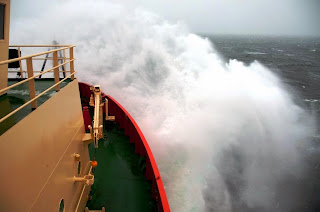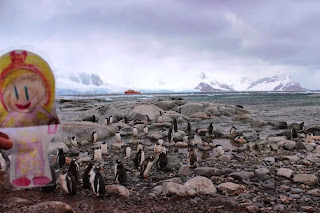Saturday, November 15, 2014
Marsh Research in Georgia
Tuesday, November 4, 2014
Successful Recovery
Deployed Instruments to measure storm waves in Croatan Sound
Saturday, August 2, 2014
Wild boar, raccoons, snakes, bugs and lots of smelly mud
Thursday, June 12, 2014
Fun with the Summester
Saturday, March 15, 2014
Almost home…reflections!
and will soon sail into the Straits of Magellan, arriving at the port of
Punta Arenas tomorrow afternoon. Our journey is ultimately coming to a
close. I leave you with these thoughts…and a few parting images of
the trip.
I left North Carolina, my boys, my fiancé, my friends, my "normal"
academic life almost 5 weeks ago and set sail for the Antarctic. It
seems like forever and a day ago and I miss everyone terribly, but this
adventure will probably seem like such a short trip when I look back in
a couple of years. During the last five weeks I have had some
incredible scientific and personal experiences. I think it is hard to
travel to this corner of the earth and not feel like you have been
granted a gift…the Antarctic is truly a treasure to behold and I feel
very lucky to have been able to visit. I hope that our experience and
our science will add to the understanding of the changes taking place
along this continent and across our globe. For those that still
question whether our planet is changing, and changing rapidly, I
encourage you to visit (by boat or internet) and witness the vast
changes currently taking place in and around the Antarctic. From ice
cover to predator-prey relationships…all are being influenced by a
changing climate, changes that will have impacts, not just here, but
across this planet.
I have enjoyed sharing this adventure with those of you that have
followed the blog and the 5th grade class I spoke with via Skype while
at Palmer Station. I can only hope that the posts and pictures provided
a window into what we have experienced, both scientifically and
personally. Although this expedition is coming to a close, the
adventures of our lab group certainly won't stop…so, keep our Blog
bookmarked and check back soon for other scientific tales!
Friday, March 14, 2014
Northward bound…
the tip of South America, only the Drake Passage stands in our way. We
are all hoping for fare seas!
The last three days or so has been yet another adventure. Prior to
setting sail from Palmer Station, we had to collect one more sample from
a recently exposed waterfall beneath one of the nearby glaciers. We
just can't seem to quench our thirst of science!! And, of course, we
couldn't leave this polar place without a Polar Plunge! Oh yes, it is
tradition to take a dip in the cold waters while you are here! As
encouragement to my crew, I vowed to don my best Superman outfit I could
come up with and take the plunge for the first time this season (I
plunged several times last season, including a ~75 meter swim across
Hero Inlet). Yes, the Superman idea was sort of a running joke of the
many superhero t-shirts I seem to wear… The plunge was great…note
the others that jumped with Superman (Kim Null, Ian Conery, and David
Young)…the hot tub afterward was even better!
We set sail on the morning of the 10th and headed for Primavera, an
Argentinian Base not too far from Palmer. It was a nice cold, snowy
morning when we arrived. Several of the techs onboard went ashore to
download some data loggers monitoring permafrost near the base. From
there, we headed to Cape Shirreff to break down a NOAA camp that has
been studying seals, penguins, and other birds in the area. This was a
great experience…
We arrived the morning of March 12th. The weather was pretty
poor…wind, snow, and very low visibility. This makes it difficult to
do zodiac operations, especially when the approach to the "beach" is
through a nice rocky reef on either side. So, we held off until the
afternoon when it cleared some. I was lucky to be chosen to help with
the zodiac ops…I was the bow man. Here is how it went: the zodiac
leaves the LMG with a large cargo net, shoots the rocky reef entrance,
hits the beach, then fills the net with all the gear, trash, samples,
etc. waiting on the beach. Then, we motor back to the LMG and attach
the cargo net to a crane that lifts the gear out of the zodiac, grab
another net, repeat (about 10-15 times). Sounds simple, right! OK, now
do this in 30 mph winds, snow, sea spray, and 8-10 ft swells
(particularly interesting when you are up against a 230 ft vessel in a
16 ft zodiac. Needless to say, it was exciting!!
We worked for about 3 hours before the weather deteriorated to the
point where we couldn't see more than about ¼ mile, making it even
more difficult. So, operations were suspended for the day in hopes of
better weather the following morning. We were able to get most of the
gear and the 6 scientist to the ship before it got too bad, so it was a
pretty good day.
The next morning (March 13th) was picture perfect. Really…no sarcasm
here. The sun was out, light breeze and good viability! Truly a
perfect day for our last Antarctic experience. In fact, it was an
incredible day to see the wildlife. From baby fur seals to feeding
leopard seals, it was an amazing morning! One I will not soon forget!
As I write, we have entered the Drake. The rolling waves pitch the LMG
to and fro…I hope for a gentle crossing and look forward to seeing
many of you soon!
I would like to give a special thanks to the Captain and Crew of the
LMG, the MPC – Adam Jenkins for all the orchestrating, the MTs –
Krista Tyburski and Ryan Wallace for all the great deck and zodiac work,
as well as many behind the scenes hours to make our research go off
without a hitch, the ETs – PQ (Paul Queior) and Kevin Pedigo for
getting the Rosette to finally behave, the MLT – Cara Ferrier for
dealing with our lab mess, and of course all the station personnel at
Palmer Station. None of this would be possible without you! THANK YOU!
Saturday, March 8, 2014
Back at Palmer Station...for a couple days
We arrived back at Palmer Station yesterday morning. We made a couple stops along the way...and then did circles for about 18 hours before laying the LMG against the dock. Let me explain...
We left Stonington Island (see a selfie and panorama) as I mentioned in my previous email. We were about a day and a half steam away. But science never rests...along the way we stopped at Deception Point to take some photos of the location for another investigator evaluating glacial-isostatic rebound (the lifting or settling of the continent after a glacier retreats...particularly important for sea level changes along the coast). He plans to install an accurate GPS that can measure changes in horizontal and vertical movement.
Next stop along the way, Peterman Island. We stopped for the researchers onboard interested in old peat deposits as a record of paleo-climate. I was lucky enough to go along with them...and took along Emma Walsh's pal, Flat Stanley (Emma, Stanley and I had a blast! see photos). Although the weather was pretty blustery, blowing 40-45mph, the researchers had a successful trip and so did the rest of us. After a couple hours on Peterman, we headed to Palmer, planning to arrive before dinner. Well, the wind didn't let up, in fact, it increased to ~50 mph. Needless to say, we couldn't dock in such windy conditions, so we had to lay off station until it lightened up a bit...18 hours later! See the picture of our cruise track that 18 hours...we were essentially doing doughnuts.
Sometimes in science you feel like you are just going in circles looking for the answer...and sometimes, well, you are actually going in circles!
We ultimately tied up yesterday, reunited with my team for the final push to pack and clean our gear and labs. We had our final inspections this morning and the crew moved aboard the LMG. So, at this point our science is essentially done. Rather, we are done collecting samples...the analysis will continue for weeks, months. We did set up a few instruments in the lab on the LMG to continue our analysis as we steam north (leaving Monday morning). So, this afternoon gave us a little time to relax... Those that know me know I don't do "relaxing" very well. So I challenged the team to a disc golf tournament. Oh yes, there is a course in the "backyard". Ok, it isn't a traditional disc golf course...the holes are large boulders, not chains. Regardless, we had a good time...and heack, it's dics golf in the Antarctic (see first picture of Jared on hole 4) Rick took the championship cup...coming in 2 under the next closest person, me!!! (BTW, I hate losing) Nice job Rick!! (the last picture is of Rick when he closed the lid on the game...we were running neck and neck until this hole. He got three strokes on me on this one hole!)
So, on Monday we begin our long steam toward home, stopping at Cape Shirreff along the way...more at that point!


















































